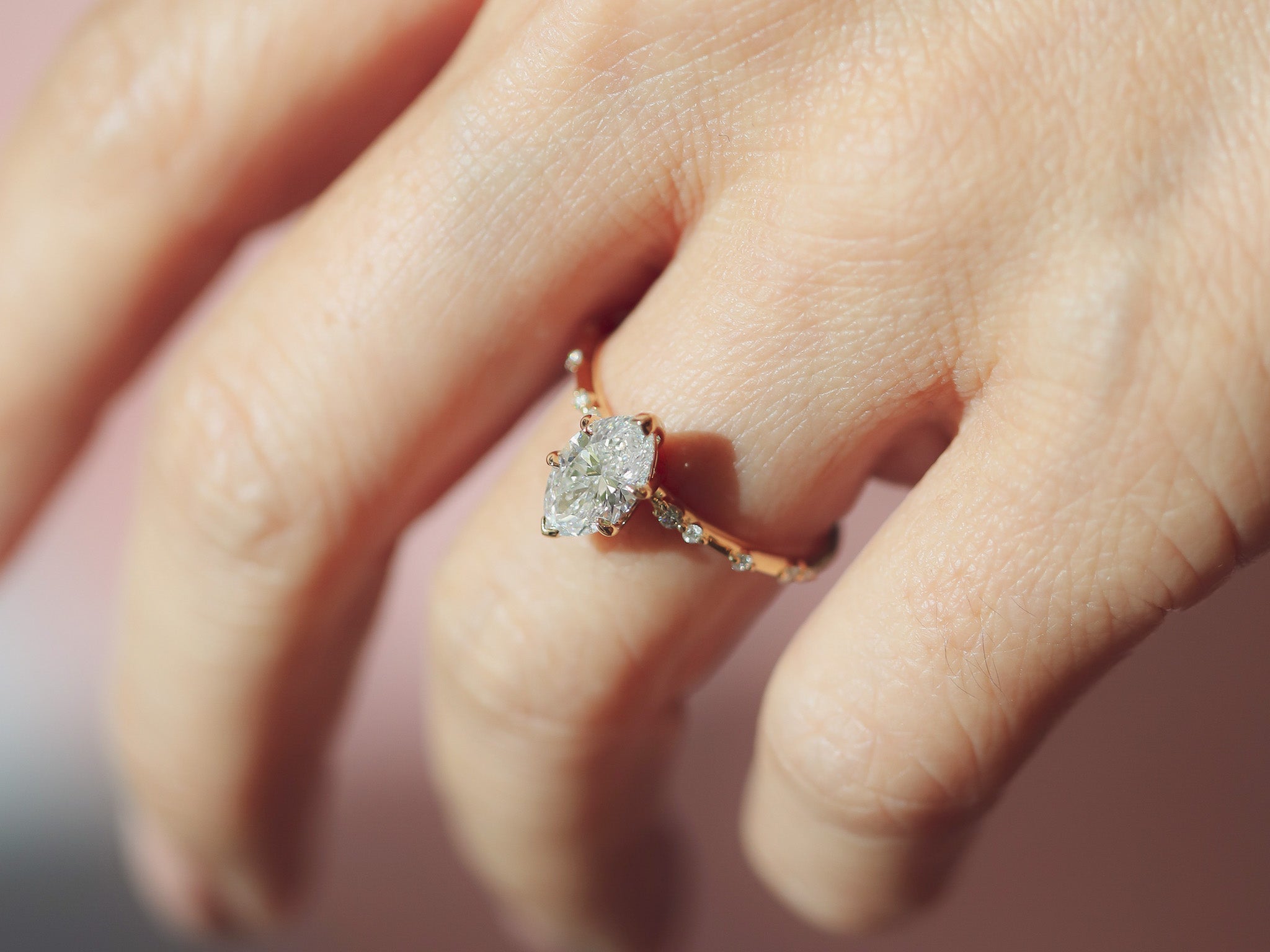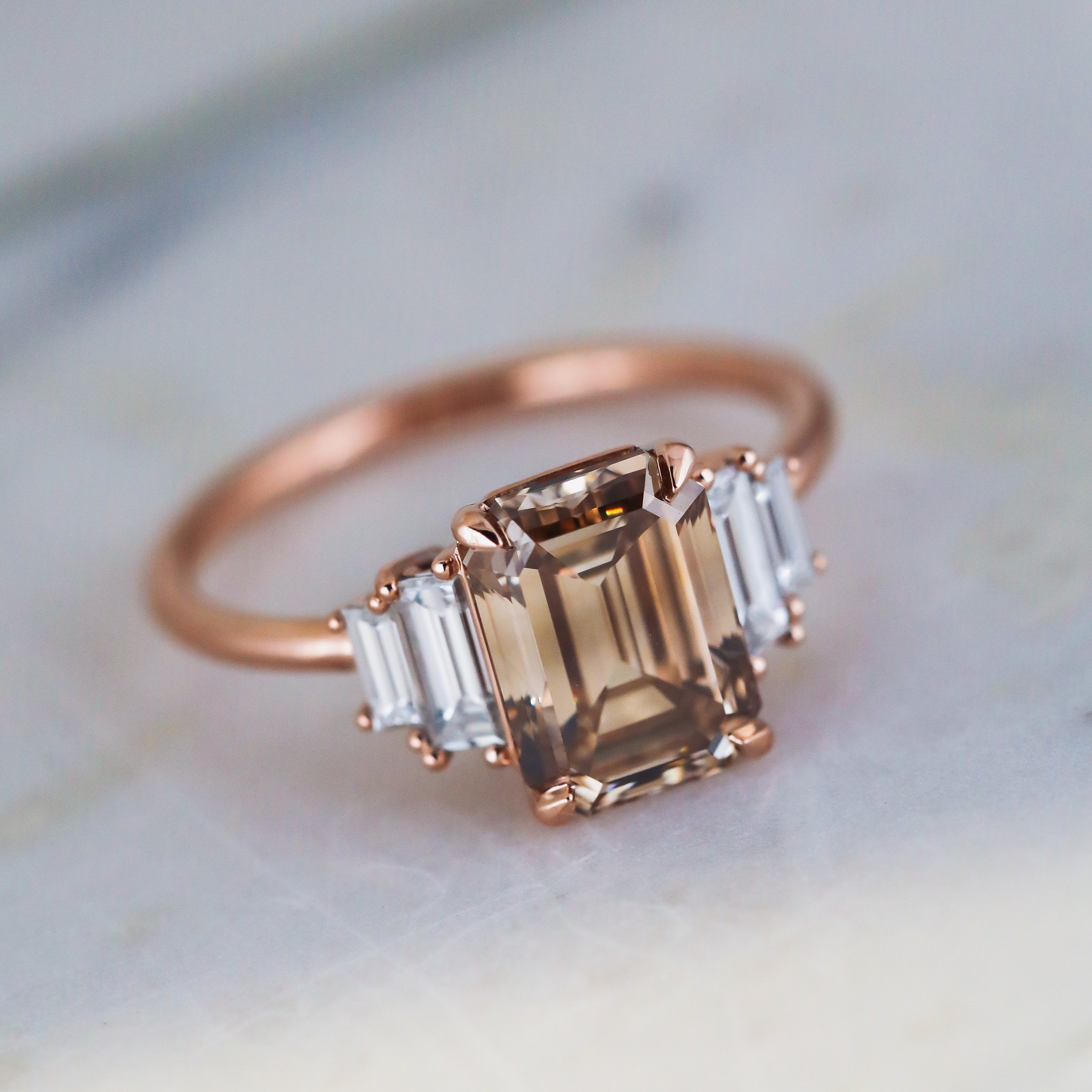Our Diamonds

When searching for Grew & Co stones to add to our inventory, we travel the world to find the best and brightest diamonds and gemstones. The stones chosen are exceptional examples of their kind, scrutinised for unique characteristics inherent to each particular variety.
What are the four c's ?
A diamond's sparkle is primarily determined by its cut, graded from Excellent to Poor. An Excellent cut reflects almost all incoming light, maximizing brilliance and light interaction.
We strongly recommend diamonds with 'Excellent' to 'Very Good' cuts, as their exceptional shape enhances the overall visual appeal of the stone. When sourcing a diamond for you, our primary focus is the cut of the stone, as it is this particular characteristic that truly brings a diamond to life.
Diamond colour is assessed on a scale from D (colourless) to Z (light yellow), with less colour being particularly sought after for its bright and pure appearance, enabling more white light reflection. Although subtle colour variations may be challenging for an untrained eye to discern, they profoundly influence the stone's overall beauty and the diamond's value.
We advise opting for stones graded between D to H, as they are considered 'white,' striking a balance between colour quality and visual appeal.
Diamond clarity refers to the internal or external imperfections called inclusions. Diamonds are graded on a scale from 'Flawless' to 'Included', with 'Flawless' having no imperfections visible under 10x magnification and 'Included' having imperfections visible to the naked eye. The fewer the inclusions, the higher the clarity grade, enhancing the diamond's brilliance. We recommend considering clarity grades from SI (Slightly Included) through to VVS (Very Very Slightly Included) and above. Diamonds in these ranges typically feature slight inclusions that are usually undetectable without magnification.
To ensure the visual quality of each stone, we meticulously inspect every diamond we intend to show you, guaranteeing that inclusions do not compromise the stone's overall appearance or value.
A carat is the unit of measure used for gemstone and diamond weight. It represents a stone's size and is equivalent to 0.2 grams.
Larger diamonds with higher carat weights, are not only rarer, but also tend to command higher prices due to their scarcity. While the weight of a stone can suggest its size, different cuts (shapes) can influence the visual impact of carat weight. For example, a comparison between a round brilliant cut and an oval cut diamond. The oval cut, with its shallower style cut and more distributed mass across the top, creates the optical illusion of a larger stone when observed from above.
When choosing a diamond, we recommend being flexible with carat weight, as the visible size of the stone is not always the result of a higher carat.
Our Values
Responsible stone sourcing lies at the heart of our values at Grew & Co, as we recognise that the integrity of our pieces relies on the quality of the materials we use. We conscientiously choose suppliers who share our commitment to environmental preservation, fair labor practices, and community well-being.
With an in-house workshop, we uphold a stringent chain of accountability for all materials, including Australian sapphires responsibly sourced from small-scale mining operations. Our stones, including diamonds, are ethically sourced and conflict-free. In many instances, we directly purchase gemstones from miners, ensuring fair profits and prioritizing the sustainable life cycle of the mines. Your choice with us not only reflects quality craftsmanship but also a commitment to ethical and sustainable practices.
White Natural Diamonds
Mined white diamonds are coveted for their rarity, natural formation and age, having developed deep within the Earth's mantle over millions of years.

The value of mined diamonds is derived from their rarity, intricately linked to their natural formation deep within the Earth's mantle over millions of years. These geological processes result in the formation of distinct and beautiful gems, each exhibiting unique characteristics. Many of our customers who choose a mined diamond are intrigued by their age and captivated by their geological history and rarity.
Natural diamonds are formed within the Earth's mantle over millions of years. Under intense pressure and elevated temperatures, carbon atoms undergo crystallization, giving rise to the unique structure of diamonds. During volcanic eruptions, these diamonds are transported closer to the Earth's surface, embedded in magma that solidifies into rocks. Over time, erosion and weathering gradually expose these diamond-rich rocks, facilitating their extraction through mining.
Polishing and cutting then transforms these diamonds into the the light-catching stones that are set into a fine jewellery pieces.
Diamond certification is a meticulous process conducted by reputable gemological laboratories to evaluate and document the quality and characteristics of a diamond. Diamonds that are certified are usually larger than 0.5ct and have a laser inscription on the girdle of the stone, matching it to its corresponding grade.
Certain certifications come with visual aids such as diagrams to highlight the unique features of the diamond. There are an array of different reputable certification houses both local and international that we recommend. We can guide you through the corresponding certification for any diamond, assisting you in making a well-informed decision when selecting a stone.

Champagne & Yellow Diamonds
The subtle brown and golden tones of champagne and yellow diamonds offers a subdued sparkle. These stones appeal to those who prefer a softened appearance in contrast to their white diamond counterparts.
Softened by subtle brown and golden tones, yellow and champagne diamonds stand apart from their white counterparts, offering a more understated stone without compromising on the captivating sparkle. We adore champagne and yellow diamonds and find those that also gravitate towards them have a love of subtle tones and soft colours.
Champagne diamonds follow a distinct colour scale separate from white diamonds, graded for colour intensity on a spectrum from 'C1' (light) to 'C7' (deep). Yellow diamonds, however, may fall within the traditional white diamond grading scale, often categorized between 'M' and 'Z'. A more exceptional category is the fancy yellow diamond, characterised by vivid color that surpasses the D-Z grading scale. With categories like ‘Fancy Intense’ and ‘Fancy Vivid’, these stones are as rare as they are captivating. Our personal preference is for suble tones and hues, with champagne diamonds ranging from C2-C4 and yellow diamonds graded from M-U in colour.
Lab Grown Diamonds
Lab-grown diamonds showcase outstanding optical properties, their impeccable cut and precisely crafted facets, result in stones that are just as stunning as their mined counterparts.

Lab-grown diamonds are crafted in controlled laboratories that emulate the natural formation of diamonds, deep within the earth. These gems possess the very same qualities as those found in nature. Choosing lab-grown diamonds provides an environmentally responsible, and often more economical option for many of our customers.
We choose to exclusively use lab grown diamonds that are formed through the CVC (Chemical Vapor Deposition) process. These diamonds are known for their exceptional purity and superior colour. This method of creation uses a tiny carbon seed which is then grown layer by layer to form a larger diamond crystal, that is ideal for cutting.
We embrace the use of lab-grown diamonds because they align with our commitment to ethical and sustainable practices. These diamonds offer a responsible and eco-friendly option, allowing us to create beautiful pieces while minimizing environmental impact. Additionally, lab-grown diamonds provide an economical choice without compromising on quality or visual appeal, ensuring our customers receive exceptional value.



